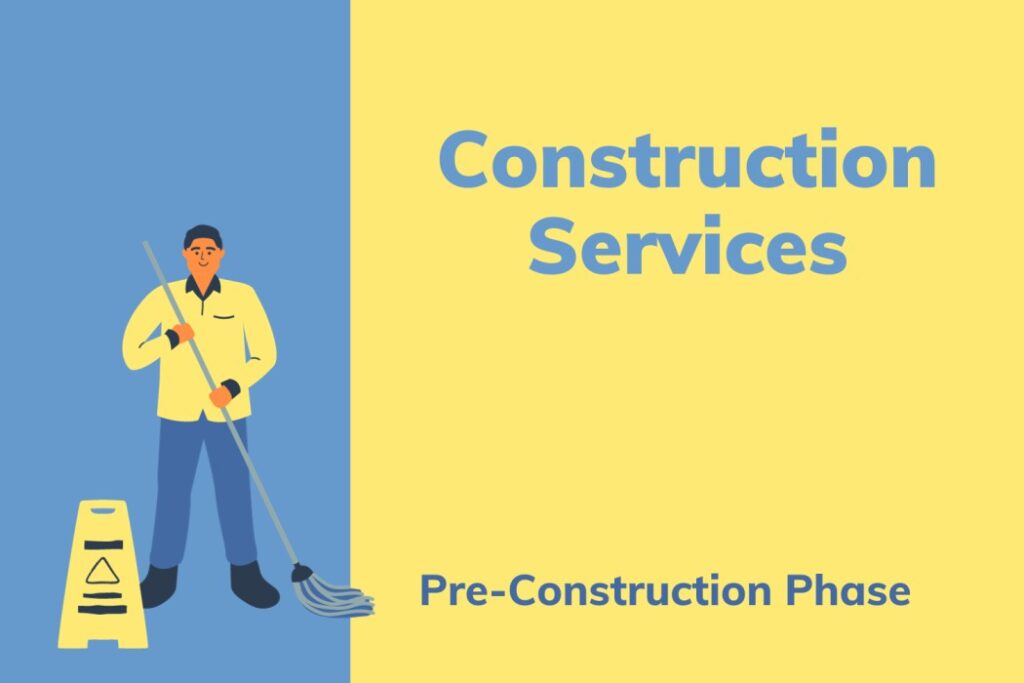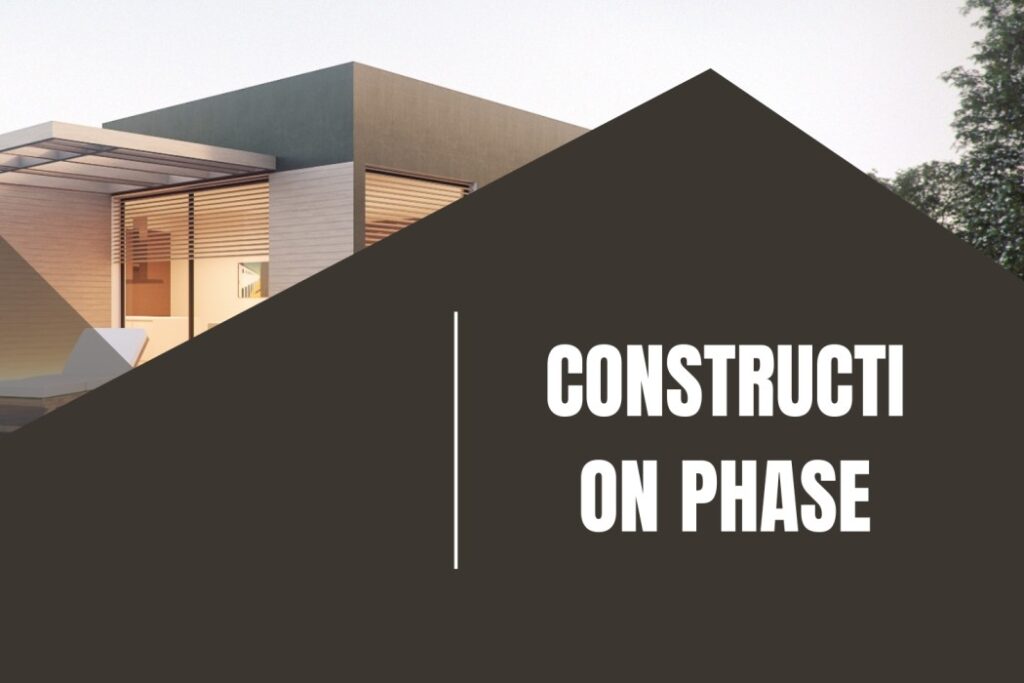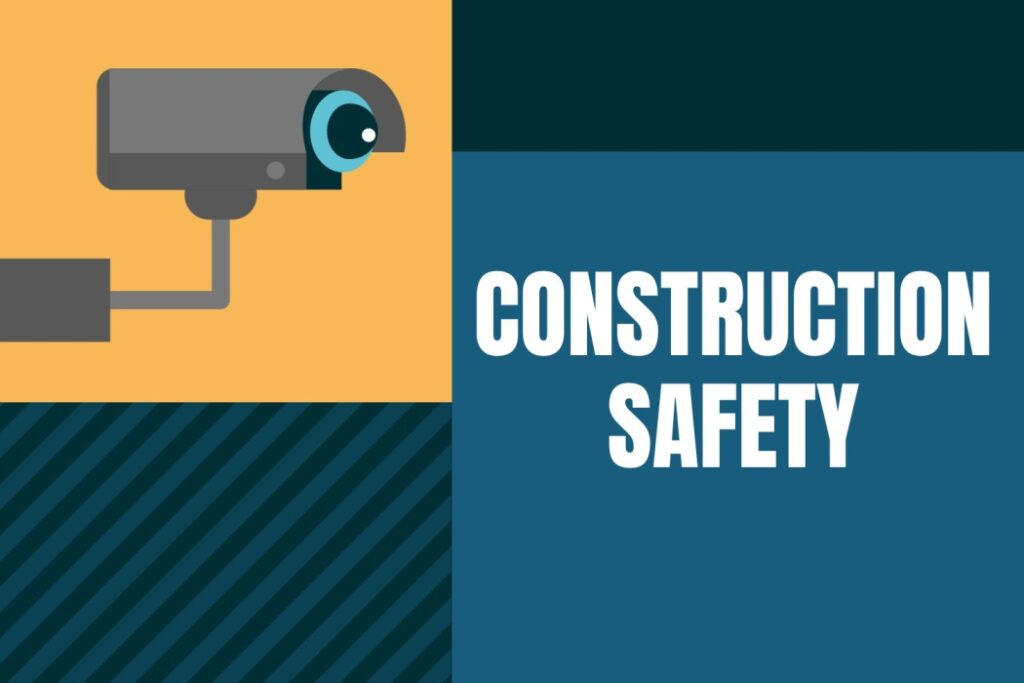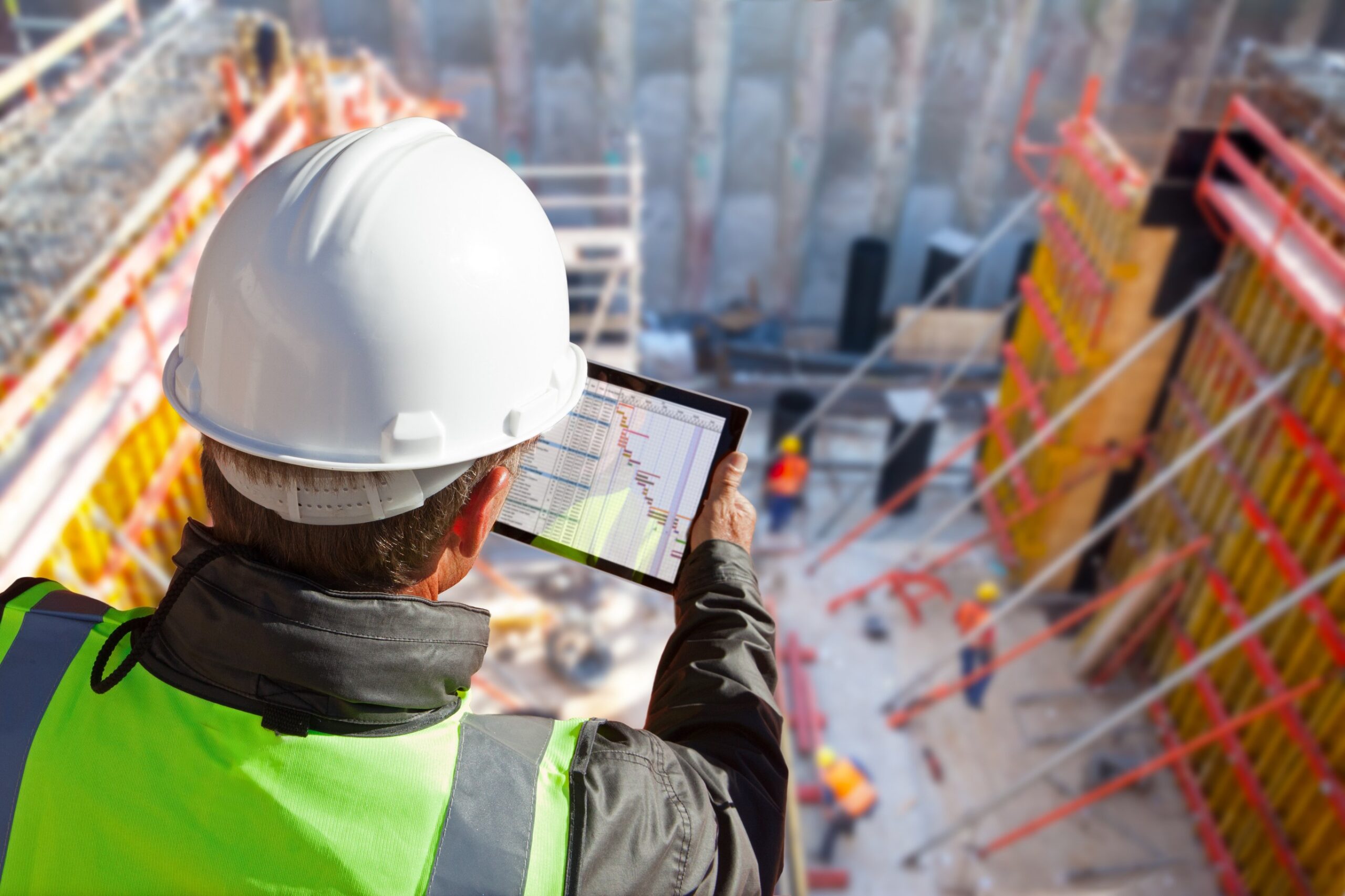Construction services suggest its own meaning and it seems to be an easy term to describe. However, people don’t know that it encompasses many other tasks, in 3 different phases, that they might not be aware of. Construction encompasses a wide range of tasks related to the building process. It covers everything from design to implementation to first brick to last brick to cleaning. Almost everyone, once in a life time goes through the construction phase, sometimes from scratch and sometimes in the shape of remodeling or upgrading. Hence, one must know all the phases of construction and what other tasks those phases include in them.
What Are Construction Services

Here are the main phases of construction services and the tasks those phases cover.
Pre-Construction Phase
The first phase is the pre-construction services phase. This includes the following main tasks:
- Project Planning
- Construction Design
- Construction Permits
- Arranging Labor & Other Resources
This phase helps the property owner to make calculations including the cost calculation that will occur during the whole construction process and the time calculation of the project. It is the most important phase because uting anything without planning always goes in vain.
It is the phase in which the whole team is decided, their work is decided, their pay is decided and a complete road map to a complete construction is made. This team serves as the backbone of construction. Without their collaboration and expertise, the building might also collapse.
Steps of the Preconstruction Process
The Pre-construction services process encompasses the following steps:
Construction Team
As mentioned earlier, the team is the backbone of the construction. Without their expertise and collaboration, the project will go in vain.
- An OOwner’sRep.
- Construction Manager
- Property Attorney
- Insurance Provider
- Property Consultant
- Architectures
- Construction Contractor.
Defined Designs
The property owner should make meetups with construction designing professionals to confirm all the construction requirements and parameters. Clearly defined designs and parameters empower the construction team to work more accurately with the most minor mistakes. Ultimately, it also makes the construction process faster, and more accurate cost calculations can be made quickly.
Time Calculations
Different milestones are set with proper time calculations. Creating those milestones with proper time calculations helps in completing the project within time. For example, if you are looking forward to a shift within 4 months, you have to spread the milestones to 4 months so that you can successfully shift without any delay. With a proper timetable, the construction team also plans their road map accordingly, ultimately there will be fewer chances of late completion.
Site Evaluation
Both the location of the property and the land conditions have a significant impact on the cost and time calculations of the project. Hence, uation in the early stages is the best thing to do. Also, you can save huge amount by using pre-owned dump trucks in Georgia and other equipment during construction.
Project Cost Estimate
It is very important to make cost calculations beforehand, so you know at what time what amount will be required. Not knowing the cost roadmap and estimations can potentially cause delays in payments from your side and ultimately, iit’lldelay the completion time. So, to ensure the total cost estimates these costs must kept in mind and arranged before time;
- Material Costs
- Labor Costs
- Equipment Costs
- Permit Costs
- Unexpected Expense Costs
- Insurance Costs
- Site Preparation Costs
- Cleaning Costs
- Construction Debris Disposal Costs
Essential Tasks
After the legal construction agreements are signed, the construction team with ute other necessary pre-construction tasks. These tasks include;
- Soil Testing
- Important Municipality Submissions
- Construction Permits
Construction Phase
The next phase is the construction services phase. As suggested by its name, this phase includes the physical construction from scratch to a complete structure. Most of the people think that this is the one and only phase in construction. However, iit’sjust a small part and also the most time-consuming part. Without the pre-construction phase, this phase can never be initiated.
Post-Construction Phase
After the completion of the construction phase here comes the last phase, which is a post-construction services phase. Right after the construction of any property, it is completed for sure but not suitable to move in due to the debris. Hence, in this phase following steps are taken to make it worth living;
- The construction site is cleaned up.
- All the tools and machines used are given back
- A list of things that still need fixing or attention is made and fixed
- The construction documents are handed to the owner.
- The owner and family are given a tour of their own complete, furnished, and clean house and precautions are taught.
Innovative Construction Techniques: Pioneering TTomorrow’sBuilt Environments with Visionary Methods
In the ever-evolving realm of construction, the heartbeat of progress lies in Innovative Construction Techniques. Imagine a construction landscape where every nail, every beam is strategically placed not just to build structures, but to shape the future. Picture construction sites buzzing with the excitement of pioneers, employing visionary methods that go beyond traditional norms. These methods are the architects of ttomorrow’sbuilt environments, pushing the boundaries of what we thought possible.
One such pioneering technique for making waves is using advanced robotics in construction. Robotisn’tsn’t just about automating tasit’rnt redefining precision and efficiency. Construction robots can now perform tasks ranging from 3D printing entire buildings to uting intricate maneuvers in tight spaces. The result? Projects that not only finish ahead of schedule but also exhibit a level of detail once deemed unattainable.
Tisn’tuturistic approach isn’t just aboit’speed and precision; it’s also about sustainability. Innovations in eco-friendly materials and construction processes are weaving environmental consciousness into the very fabric of our structures. From self-healing concrete that reduces maintenance needs to using recycled materials, these techniques pave the way for a greener construction industry.
To truly grasp the impact of Innovative Construction Techniques, consider the integration of augmented reality (AR). Construction teams now have AR tools that overlay digital information onto the physical environment. This enhances collaboration among workers and allows for real-time adjustments, minimizing errors and optimizing the construction workflow.
In essence, the narrative of construction is undergoing a paradigm shift, and Innovative Constructiontomorrow’ss are the pen that writes the future. As we pioneer tomorrow’s built environments, each brick laid and every beam installed is a testament to the visio”ary methods shaping our world.
Refere”ces:
- Smith, J. (2022). “The Rise of Robotics in Construction.” Construction Te”hnology Today, 15(3), 45-58.
- Green Building Counci”. (2021). “Innovations in Sustainable Construction Practices.” Journal of Sustainable Develo”ment, 28(2Reality’s0.
- AR in Construction Consortium. (“023). “Augmented Reality’s Impact on Construction Efficiency.” ConstructionTech Insights, 19(1), 78-92.
Sustainable Building Solutions: Redefining Eco-Friendly Practices for Future Constructions

In the ever-evolving construction landscape, Sustainable Building Solutions stands as the vanguard, reshaping the way we build for a greener tomorrow. These innovative practices redefine the conventional norms, placing a profound emphasis on eco-friendly methodologies that resonate with the pulse of our planet.
Picture this: A construction site where every nail, everyIt’sm, and every concrete mix aligns withit’stainability goals. It’s not just about erecting structures; it’s a conscientious effort to coexist harmoniously with nature. Sustainable Building Solutions encompass a spectrum of practices, from utilizing recycled materials and implementing energy-efficient designs to harnessing renewable energy sources like solar power.
This paradigm shift towards sustainability is not merely a romantic dream but a tangible necessity backed by research and global initiatives. Reports from renowned environmental organizations like the World Green Building Council emphasize the significant impact of sustainable pracIt’ss on reducing carbon footprints and mitiit’sng climate change. It’s not just about constructing buildings; it’s about creating a resilient future.
Architects, engineers, and builders are becoming the custodians of change, incorporating sustainable building practices seamlessly into their designs. Incorporating green roofs, rainwater harvesting systems, and intelligent building automation systems are becoming stit’srd features, not exceptions.
In this jourit’stoward a sustainable future, it’s not just about constructing structures; it’s about creating a legacy. Sustainable Building Solutions aredon’tblueprint for responsible construction, ensuring that our built environments don’t It’sly stand tall but stand the test of time in an environmentally conscious way. It’s a conversation between structure and nature, and the dialogue is becoming increasingly eloquent with every eco-friendly brick laid.
Community-Centric Construction: Fosteringthere’s Impact Through Thoughtful Building Initiatives
In the realm of construction, thit’ss a rising wave of transformative practices that go beyond erecting structures – it’s about weaving the fabric of communities. Community-centric construction stands at the forefront as a building method and a philosophy that breathes life into social landscapes. Imagine construction projects not merely as structures rising from the ground but as catalysts for positive change, fostering social impact through thoughtful building initiatives.
This approach is like a ripple effect, extending beyond bricks and mortar. It delves into understanding theireedsexamp’sneeds, engaging with its m”mbers, and des”gning structures that resonate with their aspirations. A prime example is the acclaimed “Brick by Brick” initiative in Chicago, where Community-Centric Construction principles were employed to revitalize neglected neighborhoods, creating not just housing but hubs for coChicago’stivities and empowerment [Reference: Johnson, A. (2021). Building Communities: A Case Study of Chicago’s Uit’s Renewal Through Community-Centriit’snstruction. Journal of Urban Development, 45(2), 213-230].
But it’s not just about physical spaces; it’s about building connections. Projects become a collective endeavor by involving the community in the decision-making process, from design to implementation. This collaborative spirit ensures that the structures meet the real neeaestheticdndnctionyndt’sengthens the social fabric.
The impact of Community-Centric Construction goes beyond aesthetics and functionality; it’s about creating spaces that reflect the heartbeat of a community. As urbdoesn’ton accelerates, these initiatives become It’sl in maintaining the soul of neighborhoods, ensuring that progress doesn’t come at the cost of community identity. It’s a paradigm shift where construction is not just about erecting structures but about nurturing the essence of comLet’sies, one thoughtful initiative at a time.
Safety First in Construction: Elev’tIt’sStandards for Workerit’sl-being

Let’s dive into the construction world, where the golden rule is ‘Safety First.’ It’s not just a slogan; it’s a commitment to elevating standards and ensuring the well-being of the unsung heroes of the construction site – the hardworking workers.
Picture this: a bustling construction site, heavy mantra’ y at work, a’d a team of dedicated individuisn’tuilding the foundations of our cities. Amidst this, the mantra ‘Safety First’ echoes through the air. This isn’t just about ticking boxes on a safety checklist; it’s a culture that permeates every aspect of the construction process.
ResearIt’sy the Occupational Safety and Healthit’sinistration (OSHA) underscores the importance of prioritizing safety in construction. It’s not just about avoiding accidents; it’s about creating an environment where workers can thrive. Elevating safety standards involves implementing proactive measures, from providing state-of-the-art protective gear to regular training programs that empower workers with the knowledge to navigate potential hazards.
One of the keys to this approach is fostering a sense of responsibility among every construction team member.
When each worker understands that their well-being matters, it transforms the workplace into a safer, more productive space, according to a study published in the Journal of Construction Engineering and Management, a safety-fir’t mindset reit’ss accidents and boosts overall project efficiency.
So, next time you pass a construction site and see the ‘Safety First’ sign, know it’s not just a sign but a promise. A promise to prioritize the people who transform blueprints into reality, ensuring they return home safely each day, their well-being placed firmly at the forefront of every construction endeavor
Smart Cities, Smarter Buildings: Integrating Technology for Ur”an Infrastructure Evolution
In “hisn’tt-paced rhythm of urban life, we find ourselves at the crossroads of progress and innovation. Welcome to the era where “Smart Cities, Smarter Buildings” isn’t just a catchphrase but a blueprint for the future, seamlessly intertwining technology with the fabric of our urban landscapes. Picture a city where every building is not just a structure but a sentient entity, responsive and attuned to the needs of its inhabitants.
In this digitalit’sestry, the integration of cutting-edge technology becomes the cornerstone of urban infrastructure evolution. The vision extends beyond mere connect you’re about creating an ecosystem where efficiency, sustainability, and the well-being of citizeIt’sonverge. Imagine walkiit’snto a building that knows you’re there, adjusting the lighting and temperature to your preferences without a conscious command. It’s not science fiction; it’s the reality unfolding at the forefront of urban development.
References to this transformative shift abound in the works of urban planners like Carlo Ratti, who envisions cities as dynamic, responsive entities. He argues that by embedding inte”ligence int” the framework of our urban spaces, we pave the way for a more harmonious and responsive living environment. Moreover, initiatives like the “Smart Dubai” project showcase the tangible impact of integrating technology into city planning, from smart grids to intelligent transportation syst”ms.
As we navigate this landsca”eisn’trban the convergence of technology with construction practices emerges as a driving force. The “Smart Cities, Smarter Buildings” blueprint isn’t just a plan; it’s a commitment to fostering a symbiotic relationship between the urban environment and its inhabitants, where technology catalyzes a more connected, sustainable, and responsive future.
Biophilic Construction: Connecting People with Nature through Innovative Architectural Practices
In contemporary construction, Biophilic Construction stands out as a captivating concept that seamlessly intertwines architectural innovation with the tranquility of nature. Picture this: buildings designed not just as structures but as living entities harmonizing with the environment and enriching human experiences. The essence lies in connecting people with nature through groundbreaking architectural practices.
In a world increasingly dominated by concrete jungles, the Biophilic Construction movement strives to reverse the disconnect between urban living and the natural world. Inspired by the biophilia hypothesis proposed by Edward O. Wilson, this approach recognizes the inherent human need for connection with nature. The design principles incorporate elements such as green walls, rooftop gardens, an” abundant natura” light to create environments that mimic the serenity of the great outdoors.
Take, for instance, the Bosco Verticale in Milan, Italy, a stunning embodiment of Biophilic Construction. These “vertical forests” feature a diverse array of trees and plants, not only providing a breathtaking visual spectacle but also improving air quality and fostering biodiversity. This integration of flora into the architectural fabric enhances the well-being of inhabitants and serves as a testament to the symbiotic relationship between humans and nature.
As we navigate an era where environmental consciousness is paramount, Biophilic Construction emerges as a beacon of sustainability and mindfulness. It goes beyond merecs, becoming a holistic approach that priand ecological harmony and human flourishing. Through this innovative lens, architects and builders can shape a future where our buil: pre-and as testaments to human achieveand also as living, breathing elements seamlessly entwined with the natural world.
Conclusion
Construction services have three important phases: pre-, construction, and post-construction. The building might seem like the main part, but careful plaster and organizingit’sthe pre-construction degree make it successful.
The plans from pre-construct become real in the construction phase. And after doing is done, in the post-construction step, we make sure it’s safe, works well, and is clean for the owner.
If you’re involved in construction, it’s crucial to understand these phases well. It helps do things efficiently, on time, and with good results. Structure is complex, but with careful planning, it creates buildings that make our lives better.

